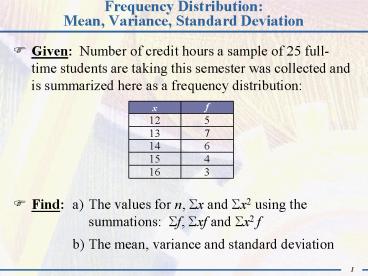Frequency Distribution: Mean, Variance, Standard Deviation - PowerPoint PPT Presentation
Title:
Frequency Distribution: Mean, Variance, Standard Deviation
Description:
Frequency Distribution: Mean, Variance, Standard Deviation Given: Number of credit hours a sample of 25 full-time students are taking this semester was collected and ... – PowerPoint PPT presentation
Number of Views:192
Avg rating:3.0/5.0
Title: Frequency Distribution: Mean, Variance, Standard Deviation
1
Frequency DistributionMean, Variance, Standard
Deviation
- Given Number of credit hours a sample of 25
full-time students are taking this semester was
collected and is summarized here as a frequency
distribution
- Find a) The values for n, ?x and ?x2 using the
summations ?f, ?xf and ?x2 f
b) The mean, variance and standard deviation
2
Understanding a Frequency Distribution
- A sample of 25 data is summarized here as a
frequency distribution
- For the above frequency distribution,
- a) What do the entries x 12 and f 5 mean?
The x-value 12 occurred 5 times in the sample
b) If you total the values listed in the
x-column, what would this total represent?
It would be the sum of the 5 distinct x-values
occurring in the sample, not the sum of all 25
values
- Remember, the ?x represents the sum of all data
values for thesample - this sample has 25 data,
not 5 as listed in the x-column
3
Finding the Extensions Summations
- Use a table format to find the extensions for
each x value and the 3 summations ?f, ?xf and ?x2
f
?f 25
?xf 343
?x2f 4747
1. Find n
The sample size n is ?f, the sum of the
frequencies
The sample size n ?f 25
2. Find the sum of all data by finding ?xf
Find xf for each x
The sum of all data ?xf 343
3. Find the sum of all squared data by finding
x2f
First, find x2 for each x
Second, find x2f for each x
The sum of all squared data ?x2f 4747
Notes Save these 3 summations for future formula
work DO NOT find the summations of the x and x2
columns
4
Finding the Sample Mean
- Formula 2.11 will be used
- Previously determined values ?f 25, ?xf 343
343
343
13.72
25
25
The sample mean is 13.7 credit hours
5
Finding the Sample Variance
- Formula 2.16 will be used
- Previously determined values
?x2f 4747
?xf 343
?f 25
343
343
4747
4747
The sample variance is 1.71
6
Finding the Sample Standard Deviation
- The standard deviation is the square root of
variance
- Therefore, the standard deviation is
1.71
1.3077
1.3
The standard deviation is 1.3 credit hours
Notes 1) The unit of measure for the standard
deviation is the unit of the data 2) Use a
non-rounded value of variance when calculating
the standard deviation
7
Using a Grouped Frequency Distribution
- Given Twenty-five men were asked, How much did
you spend at the barber shop during your last
visit? The data is summarized using intervals
and is listed here as a grouped frequency
- Find a) The class midpoint for each class
- b) Estimate the values for n, ?x and ?x2 using
the summations ?f, ?xf and ?x2f - c) The mean, variance and standard deviation
8
Finding the Class Midpoint
- Each class interval contains several different
data values. In order to use the frequency
distribution, a class midpoint must be determined
for each class. This center value for the class
will be used to approximate the value of each
data that belongs to that class. The class
midpoints are found by averaging the extreme
values for each class
5.0
5.0
10.0
10.0
- Find The class midpoints, one class at a
time (lower boundary upper boundary) / 2
12.50
7.50
2.50
7.50
2.50
7.50
7.50
12.50
5.0
10.0
The midpoint for each class will the be the
classs representative value and be used for
finding the extensions
9
Finding the Extensions Summations
- Use a table format to find the extensions for
each x value and the 3 summations ?f, ?xf and ?x2
f
?f 25
?xf 305
?x2f 4625
meaningless totals
1. For x2, multiply each x by itself
2. For xf, multiply each x by its frequency f
3. For x2f, multiply each x2 by its frequency f
4. Find the summations by totaling the columns
Notes Save these 3 summations for future formula
work DO NOT find the summations for the x and x2
columns
10
Finding the Sample Mean
- Formula 2.11 will be used
- Previously determined values ?f 25, ?xf 305
305
305
12.2
25
25
The sample mean is 12.20
11
Finding the Sample Variance
- Formula 2.16 will be used
- Previously determined values
?x2f 4625
?xf 305
?f 25
305
305
4625
4625
The sample variance is 37.7
12
Finding the Sample Standard Deviation
- The standard deviation is the square root of
variance
- Therefore, the standard deviation is
37.6666
6.1367
6.14
The standard deviation is 6.14
Notes 1) The unit of measure for the standard
deviation is the unit of the data 2) Use a
non-rounded value of variance when calculating
the standard deviation































